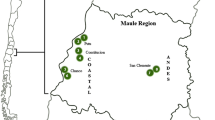Abstract
Tissue culture seedlings of the hybrid Cymbidium were inoculated with six different fungal strains, isolated from the roots of different wild terrestrial orchids. About three months later, the average increment of fresh weight of seedlings inoculated with strains CF1, CF3 and CF12 were respectively 130.26%, 345.65% and 153.34% while that of the control was only 88.40%. The differences between the three treatments and the control were statistically significant (α = 0.05), highlighting the treatment with strain CF3 (α = 0.01). In addition, the three strains were obtained by re-isolating. Pelotons, regarded as typical structures of orchid mycorrhiza, were also found in the inoculating roots under a microscope. It seems that the strains of CF1, CF3, and CF12 are associated with the hybrid Cymbidium and supplied the orchid with nutrition. It can be confirmed that the three strains are beneficial for the seedlings of this hybrid.
Similar content being viewed by others
References
Chen C, Chang W C. 2000. Micropropagation of Cymbidium ensifolium var. misericors through callus-derived rhizomes. Vitro Cell Dev Biol, 36(6): 517–520
Dijk E, Eck N D. 1995. Effects of mycorrhizal fungi on in vitro nitrogen response of some Dutch indigenous orchid species. Can J Bot, 73: 1,203–1,211
Ding H, Han S F, Wang G P, Huang M R, Feng Y. 2002. Symbiosis between Cattleya sp. and Rhizoctonia sp. and mycorrhiza microstructure of Cattleya sp. Mycosystema, 21(3): 425–429 (in Chinese with English abstract)
Fan L, Guo S X, Cao W Q, Xiao P G, Xu J T. 1996. Isolation, culture, identification and biological activity of Mycena orchidicola sp. nov. in Cymbidium sinense (Orchidaceae). Acta Mycol Sin, 15(4): 251–255 (in Chinese with English abstract)
Fan L, Guo S X, Xiao P G. 1999. Study on structure and localization of acid phosphatase of mycorrhizal root of Cymbidium sinense (Orchidaceae). Acta Bot Yunnan, 21(2): 197–201 (in Chinese with English abstract)
Fang Z D. 1998. Plant Disease Research Method. 3rd ed. Beijing: China Agricultural Press (in Chinese)
Horticultural Group of Beijing Forestry University. 2004. Flower School. Beijing: China Forestry Publishing House (in Chinese)
Hadley G, Williamson B. 1972. Features of mycorrhizal infection in some Malayan orchids. New Phytol, 71: 1,111–1,118
Li M. 2004. Studies on mycorrhiza of Cymbidium lianpan. J Yunnan Norm Univ, 24(1): 55–57 (in Chinese with English abstract)
Li M. 2006. Research and Application of Orchidaceae Mycorrhiza. Kunming: Yunnan University Press (in Chinese)
Lv M, Wu J R, Ma H C. 2005. Observation of the microstructure of Cymbidium goeringii mycorrhiza. Southwest For Coll, 25(2): 8–11 (in Chinese with English abstract)
Pan C M, Chen R M, Ye Q S. 2002. A study on mycorrhizal microstructure of wild Cymbidium ensifolium. Guangzhou Univ Trad Chin Med, 19(1): 60–62 (in Chinese with English abstract)
Wang L M, Wang S Q. 2006. The growth effect of protocorm-like body (PLB) germinated from seeds of Cymbidium hybridum on different medium. Seed, 25(12): 8–11 (in Chinese with English abstract)
Wu J R, Han S F, Zhu Y Y, Lv M, Wang H P, Guo W L. 2005. Ultra-structure of symbiosis mycorrhizal between Cymbidium goeringii and Rhizoctonia sp. Nanjing For Univ (Nat Sci Ed), 29(4): 105–l08 (in Chinese with English abstract)
Wu Y X. 1993. The Orchids of China. 2nd ed. Beijing: China Forestry Publishing House (in Chinese)
Xu J T, Fan L. 2001. Cytodifferentiation of the seeds (Protocorms) and vegetative propagation corms colonized by mycorrhizal fungi. Acta Bot Sin, 43(10): 1,003–1,010 (in Chinese with English abstract)
Yang G M, Ren H T, Yang Y H, Yang Y H Zhang L J. 2004. Study on the culture media of Cymbidium hybridum. Agric Sci Tech, 7: 39–40 (in Chinese with English abstract)
Yao L J, Chen Y Z, Xu X W, Lin S S, Chen Z L, Zeng A P. 2006. Study on radication, strong seedlings and transport of Cymbidium hybridum. Chekiang Agric Sci, 2: 133–135 (in Chinese with English abstract)
Yao X H, Wang L M. 2005. Studies on liquid of seeds of Cymbidium hybridum. Agric Sci Bull, 21(8): 256–259 (in Chinese with English abstract)
Author information
Authors and Affiliations
Corresponding author
Rights and permissions
About this article
Cite this article
Dong, F., Liu, Hx., Jin, H. et al. Symbiosis between fungi and the hybrid Cymbidium and its mycorrhizal microstructures. For. Stud. China 10, 41–44 (2008). https://doi.org/10.1007/s11632-008-0002-1
Received:
Accepted:
Published:
Issue Date:
DOI: https://doi.org/10.1007/s11632-008-0002-1




